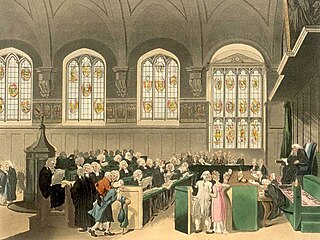At common law, damages are a remedy in the form of a monetary award to be paid to a claimant as compensation for loss or injury. To warrant the award, the claimant must show that a breach of duty has caused foreseeable loss. To be recognized at law, the loss must involve damage to property, or mental or physical injury; pure economic loss is rarely recognized for the award of damages.
A tort is a civil wrong, other than breach of contract, that causes a claimant to suffer loss or harm, resulting in legal liability for the person who commits the tortious act. Tort law can be contrasted with criminal law, which deals with criminal wrongs that are punishable by the state. While criminal law aims to punish individuals who commit crimes, tort law aims to compensate individuals who suffer harm as a result of the actions of others. Some wrongful acts, such as assault and battery, can result in both a civil lawsuit and a criminal prosecution in countries where the civil and criminal legal systems are separate. Tort law may also be contrasted with contract law, which provides civil remedies after breach of a duty that arises from a contract. Obligations in both tort and criminal law are more fundamental and are imposed regardless of whether the parties have a contract.

In contract law, an indemnity is a contractual obligation of one party to compensate the loss incurred by another party due to the relevant acts of the indemnitor or any other party. The duty to indemnify is usually, but not always, coextensive with the contractual duty to "hold harmless" or "save harmless". In contrast, a "guarantee" is an obligation of one party to another party to perform the promise of a relevant other party if that other party defaults.
In English civil litigation, costs are the lawyers' fees and disbursements of the parties.

Subrogation is the assumption by a third party of another party's legal right to collect debts or damages. It is a legal doctrine whereby one person is entitled to enforce the subsisting or revived rights of another for their own benefit. A right of subrogation typically arises by operation of law, but can also arise by statute or by agreement. Subrogation is an equitable remedy, having first developed in the English Court of Chancery. It is a familiar feature of common law systems. Analogous doctrines exist in civil law jurisdictions.

English tort law concerns the compensation for harm to people's rights to health and safety, a clean environment, property, their economic interests, or their reputations. A "tort" is a wrong in civil law, rather than criminal law, that usually requires a payment of money to make up for damage that is caused. Alongside contracts and unjust enrichment, tort law is usually seen as forming one of the three main pillars of the law of obligations.

In common law jurisdictions, a misrepresentation is a false or misleading statement of fact made during negotiations by one party to another, the statement then inducing that other party to enter into a contract. The misled party may normally rescind the contract, and sometimes may be awarded damages as well.
Public liability is part of the law of tort which focuses on civil wrongs. An applicant usually sues the respondent under common law based on negligence and/or damages. Claims are usually successful when it can be shown that the owner/occupier was responsible for an injury, therefore they breached their duty of care.

English contract law is the body of law that regulates legally binding agreements in England and Wales. With its roots in the lex mercatoria and the activism of the judiciary during the Industrial Revolution, it shares a heritage with countries across the Commonwealth, from membership in the European Union, continuing membership in Unidroit, and to a lesser extent the United States. Any agreement that is enforceable in court is a contract. A contract is a voluntary obligation, contrasting to the duty to not violate others rights in tort or unjust enrichment. English law places a high value on ensuring people have truly consented to the deals that bind them in court, so long as they comply with statutory and human rights.

Bristol and West Building Society v Mothew [1996] EWCA Civ 533 is a leading English fiduciary law and professional negligence case, concerning a solicitor's duty of care and skill, and the nature of fiduciary duties. The case is globally cited for its definition of a fiduciary and the circumstances in which a fiduciary relationship arises.

Leaf v International Galleries [1950] 2 KB 86 is an English contract law case concerning misrepresentation, mistake and breach of contract, and the limits to the equitable remedy of rescission.

Royscot Trust Ltd v Rogerson[1991] EWCA Civ 12 is an English contract law case on misrepresentation. It examines the Misrepresentation Act 1967 and addresses the extent of damages available under s 2(1) for negligent misrepresentation.

Robinson v Harman (1848) 1 Ex Rep 850 is an English contract law case, which is best known for a classic formulation by Parke B on the purpose and measure of compensatory damages for breach of contract that,
the rule of the common law is, that where a party sustains loss by reason of a breach of contract, he is, so far as money can do it to be placed in the same situation, with respect to damages, as if the contract had been performed.

Addis v Gramophone Co Ltd [1909] AC 488 is an old English contract law and UK labour law case, which used to restrict damages for non-pecuniary losses for breach of contract.

The Misrepresentation Act 1967 is a United Kingdom act of Parliament of the United Kingdom which amended the common law principles of misrepresentation. Prior to the Act, the common law position was that there were two categories of misrepresentation: fraudulent and innocent. The effect of the act is primarily to create a new category by dividing innocent misrepresentation into two separate categories: negligent and "wholly" innocent; and it goes on to state the remedies in respect of each of the three categories.

Esso Petroleum Co Ltd v Mardon [1976] EWCA Civ 4 is an English contract law case, concerning misrepresentation. It holds that the divide between a statement of opinion and fact becomes more factual if one holds himself out as having expert knowledge.

Doyle v Olby (Ironmongers) Ltd [1969] 2 QB 158 is an English contract law case concerning fraudulent misrepresentation. It illustrates and emphasizes the differing measures of damages for deceit and breach of contract.

Government of Zanzibar v British Aerospace Ltd [2000] EWHC 221 (Comm) is an English contract law case, concerning misrepresentation.

C&P Haulage Co Ltd v Middleton [1983] EWCA Civ 5 is an English contract law case, concerning damages for costs incurred by a claimant related to a defendant's breach of contract.
Insurance in South Africa describes a mechanism in that country for the reduction or minimisation of loss, owing to the constant exposure of people and assets to risks. The kinds of loss which arise if such risks eventuate may be either patrimonial or non-patrimonial.












